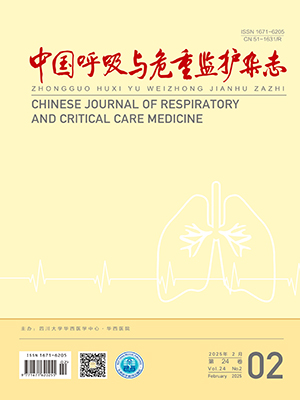| 1. |
Rezaiguia S, Jayr C. Prevention of respiratory complications after abdominal surgery. Ann Fr Anesth Reanim, 1996, 15: 623-646.
|
| 2. |
Ferguson MK. Preoperative assessment of pulmonary risk. Chest,1999, 115( 5 suppl) : 58S-63S.
|
| 3. |
Weissman C. Pulmonary complications after cardiac surgery. Seminars Cardiothoracic Vascular Anesthesia, 2004, 8: 185 -211.
|
| 4. |
Lawrence VA, Hilsenbeck SG, Noveck H, et al. Medical complications and outcomes after hip fracture repair. Arch Intern Med, 2002 ,162: 2053-2057.
|
| 5. |
Ntoumenopoulos G. Indications for manual lung hyperinflation ( MHI) in the mechanically ventilated patient with chronic obstructive pulmonary disease. Chron Respir Dis, 2005, 2: 199-207.
|
| 6. |
Thomas EJ, Goldman L, Mangione CM, et al. Body mass index as a correlate of postoperative complications and resource utilization. AmJ Med, 1997, 102: 277-283.
|
| 7. |
Rosen AK, Geraci JM, Ash AS, et al. Postoperative adverse events of common surgical procedures in the Medicare population. Med Care,1992, 30: 753-765.
|
| 8. |
Escarce JJ, Shea JA, Chen W, et al. Outcomes of open cholecystectomy in the elderly: a longitudinal analysis of 21, 000 cases in the prelaparoscopic era. Surgery, 1995, 117: 156-164.
|
| 9. |
Pedersen T. Complications and death following anaesthesia: a prospective study with special reference to the influence of patient-,anaesthesia-, and surgery-related risk factors. Dan Med Bull, 1994 ,41: 319-331.
|
| 10. |
American Association for Respiratory Care. AARC clinical practice guideline: Incentive spirometry. Respir Care, 1991, 36: 1402-1405.
|
| 11. |
Sabaratnam S, Eng J, Mearns AJ. Alterations in respiratory mechanics following thoracotomy. J R Coll Surg Edinb, 1990, 35: 144-150.
|
| 12. |
Bastin R, Moraine JJ. IS performance. A reliable indicator of pulmonary function in the early postoperative period after lobectomy?Chest, 1997, 113: 552.
|
| 13. |
Weiner P. The effect of IS and respiratory muscle training on pulmonary function after lung resection. J Thorac Cardiovasc Surg, 1997 ,113 : 552.
|
| 14. |
Hulzebos EH, Helders PJ, Favie NJ, et al. Preoperative intensive inspiratory muscle training to prevent postoperative pulmonary complications in high-risk patients undergoing CABG surgery. A randomized clinical trial. JAMA, 2006, 296 : 1851 -1857.
|
| 15. |
Webber BA, Pryor JA, ed. Physiotherapy skills: techniques and adjuncts. In: Physiotherapy for Respiratory and Cardiac Problems. London: Churchill Livingstone, 1993, 113-172.
|
| 16. |
American Association for Respiratory Care. The pros and cons of IPPB: AARC provides an assessment on its effectiveness. AARC Times, 1986, 10: 48.
|
| 17. |
钱元诚, 主编. 呼吸治疗的基础与临床. 北京: 人民卫生出版社, 2003, 309-320.
|
| 18. |
Scanlan CL, Wilkins RL, Stoller JK. Egan’s fundamentals of respiratory care, 7th ed. St Louis:Mosby, 1999, 777-782.
|
| 19. |
American Thoracic Society ( ATS) . As quoted in intermittent positive pressure breathing therapy. AHCPR Health Technology Assessment Reports, 1991 , 1: 5.
|
| 20. |
Pedersen JZ, Bundgaard A. Comparative efficacy of different methods of nebulizing terbutaline. Eur J Clin Pharmacol, 1983, 25: 739-742.
|
| 21. |
Fergusson RJ, Carmichael J, Rafferty P, et al. Nebulized salbutamol in lifethreatening asthma: is IPPB necessary? Br J Dis Chest, 1983 ,77: 255-261.
|
| 22. |
Eggertsen SC. Intermittent positive pressure breathing and the treatment of acute asthma. J Fam Pract, 1983 , 16: 909 -913.
|
| 23. |
Aelony Y. “Noninvasive”oral treatment of asthma in the emergency room. Am J Med, 1985 , 78( 6 Pt 2) : 929 -936.
|
| 24. |
Webber BA, Collins JV, Branthwaite MA. Severe acute asthma: a comparison of three methods of inhaling salbutamol. Br J Dis Chest,1982, 76: 69-74.
|
| 25. |
Branscomb BV. Metaproterenol solution in the treatment of asthmatic patients by intermittent positive pressure breathing. J Clin Pharmacol, 1982, 22: 231-235.
|
| 26. |
Anderson PB, Goude A, Peake MD. Comparison of salbutamol given by intermittent positive-pressure bre athing and pressure-packed aerosol in chronic asthma. Thorax, 1982 , 37: 612 -616.
|
| 27. |
Ingwersen UM, Larsen KR, Bertelsen MT, et al. Three different mask physiotherapy regimens for prevention of postoperative pulmonary complications after heart and pulmonary surgery. Intensive Care Med, 1993, 19: 294-298.
|
| 28. |
Richter Larsen K, Ingwersen U, Thode S, et al. Mask physiotherapy in patients after heart surgery: a controlled study. Intensive Care Med, 1995, 21: 469-474.
|
| 29. |
American Association for Respiratory Care. Clinical practice guideline:Use of positive airway pressure adjuncts to bronchial hygiene therapy. Respir Care, 1993, 38: 516-521.
|
| 30. |
Mahlmeister MJ, Fink JB, Hoffman GL, et al. Positive-expiratorypressure mask therapy: theoretical and practical considerations and a review of the literature. Respir Care, 1991, 36: 1218-1230.
|
| 31. |
Lindner K, Lotz P, Ahnefeld F. Continuous positive airway pressure effect on functional residual capacity, vital capacity and its subdivisions.Chest, 1987, 92: 66-70.
|
| 32. |
Putensen C, Hormann C, BaumM, et al. Comparison of mask and nasal continuous positive airway pressure after extubation and mechanical ventilation. Crit Care Med, 1993, 21: 357-363.
|




